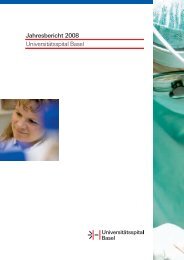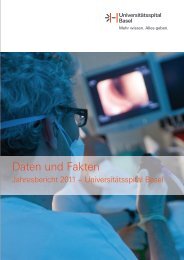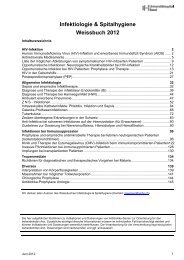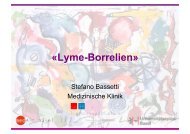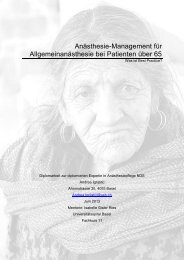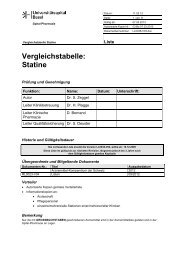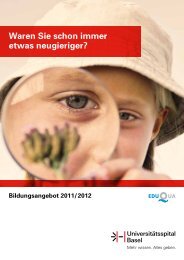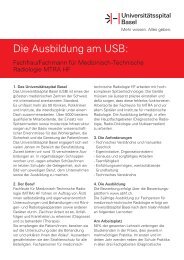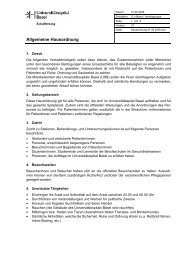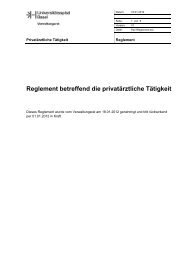Transmucosal Nasal Drug Delivery: Systemic Bioavailability of ...
Transmucosal Nasal Drug Delivery: Systemic Bioavailability of ...
Transmucosal Nasal Drug Delivery: Systemic Bioavailability of ...
You also want an ePaper? Increase the reach of your titles
YUMPU automatically turns print PDFs into web optimized ePapers that Google loves.
7. Project III: <strong>Transmucosal</strong> nasal delivery <strong>of</strong> low-dose midazolam – evaluation <strong>of</strong> two preparations for procedural anxiolysis<br />
Due to his excellent experiences with i.v. anxiolysis during a former MRI examination, after<br />
administration <strong>of</strong> the initial nasal dose <strong>of</strong> midazolam he requested i.v. application <strong>of</strong> an anxiolytic<br />
treatment.<br />
Generally, if anxiolysis <strong>of</strong> the initial treatment with 1 mg midazolam (MD or UD) was not sufficient to<br />
perform MRI examination, one additional dose <strong>of</strong> 1 mg midazolam was administered.<br />
All patients, refusing or interrupting the MRI examinations (therapy failures, n=3) were treated with<br />
2 mg midazolam. Probably in these cases, diffuse anxiety and/or claustrophobia were too intense<br />
to be cured with low-doses <strong>of</strong> midazolam (1-2 mg). But due to small number <strong>of</strong> patients requiring<br />
2 mg midazolam, statistical analysis <strong>of</strong> the intensity <strong>of</strong> anxiety is not reasonable.<br />
Acquired data <strong>of</strong> one patient had to be excluded from final analysis, because <strong>of</strong> protocol deviation.<br />
This patient <strong>of</strong> the comparator group was initially treated with UD nasal spray but the additional<br />
dose was administered by MD nasal spray.<br />
As anxious patients are generally agitated they tend to move during MRI examination impairing<br />
image quality by generating motion artifacts. In a prospective double-blind placebo controlled<br />
randomized trial Hollenhorst et al. demonstrated significant reduction <strong>of</strong> MRI related anxiety in<br />
patients receiving nasal midazolam, and the reported anxiety reduction correlated with improved<br />
image quality. In the present multicenter study with nasal midazolam, overall 91 patients (MD n=42<br />
and UD n=49) were treated 1 mg nasal midazolam (initial dose). All <strong>of</strong> them successfully completed<br />
MRI examination and the generated MRI images were <strong>of</strong> good or even excellent quality.<br />
No patient fell asleep and therefore all patients were able to appropriately respond to instructions<br />
given during MRI examination. All MRI examinations were rated as normally feasible by radiologic<br />
technician. Beside local irritation for both tested midazolam nasal spray no adverse drug reaction<br />
was reported.<br />
The parameters to assess the benefit <strong>of</strong> nasal anxiolysis for anxious patients undergoing MRI<br />
examination were: anxiety score before medication and after completing <strong>of</strong> the MRI examination,<br />
tolerance <strong>of</strong> nasal administration, local irritation, and willingness to repeat the MRI examination with<br />
the analog medication receiving in the study.<br />
Regarding subjective anxiety reduction, willingness to repeat the procedure, and diagnostic image<br />
quality, the tested nasal sprays (MD and UD) were equivalent. Concerning convenience <strong>of</strong><br />
administration (i.e., delivery independent <strong>of</strong> position) and hygienic security UD nasal spray was<br />
rated as superior to MD nasal spray.<br />
Katja Suter-Zimmermann Page 94 <strong>of</strong> 188 University <strong>of</strong> Basel, 2008




